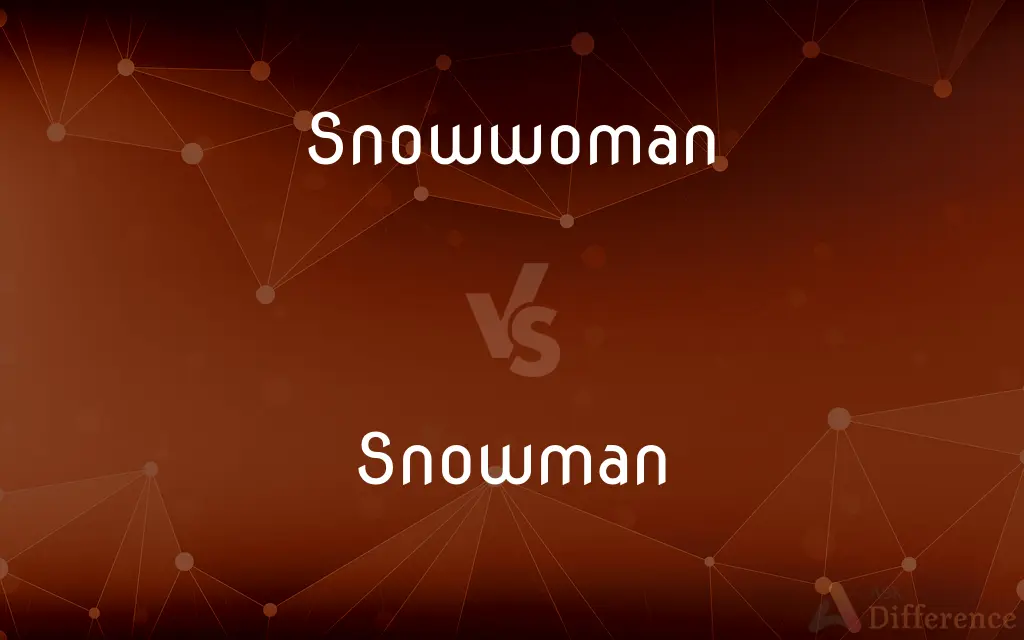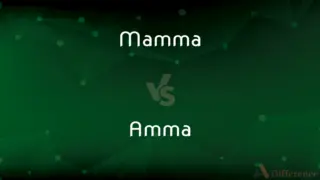Snowwoman vs. Snowman — What's the Difference?
By Tayyaba Rehman & Fiza Rafique — Updated on March 14, 2024
A snowwoman is a snow sculpture representing a female figure, often marked by added feminine attributes, while a snowman typically depicts a male figure with simpler, generic features.

Difference Between Snowwoman and Snowman
Table of Contents
ADVERTISEMENT
Key Differences
Snowwomen are often created with distinct feminine attributes, such as long hair made from yarn or clothing that is traditionally considered feminine, such as skirts or dresses. This customization adds to the creativity and diversity of snow sculptures. On the other hand, snowmen are generally depicted with more generic human features, like coal for eyes and carrots for noses, and are often accessorized with items like scarves and hats, which are not necessarily gender-specific.
While building a snowwoman might include additional accessories or features to emphasize femininity, such as using twigs to create the illusion of eyelashes or adding a purse made from snow, snowmen are frequently characterized by their simplicity and iconic three-ball structure. This difference in complexity and detail can affect both the time investment and the creative process involved in building these figures.
The tradition of building snowwomen and snowmen varies culturally and regionally, with some cultures putting a stronger emphasis on representing gender differences in their snow sculptures. Snowmen, due to their long-standing presence in winter folklore and media, are more universally recognized and have a more standardized appearance, whereas snowwomen might be subject to a wider range of interpretations based on local customs and individual creativity.
Community events and competitions may also reflect differences in constructing snowwomen and snowmen, with certain contests focusing on innovation and artistic expression that encourages elaborate designs for snowwomen, including the use of colored snow, fabrics, or other materials. Conversely, snowmen contests might prioritize traditional designs, emphasizing craftsmanship and adherence to classic snowman imagery.
In children's literature and media, snowmen are often featured as central characters in winter stories, embodying themes of magic, wonder, and ephemeral beauty. Snowwomen, while also present, may not be as predominant but offer opportunities for stories that challenge traditional gender roles or celebrate diversity and inclusion through their unique representations.
ADVERTISEMENT
Comparison Chart
Primary Attributes
Feminine features (e.g., skirts, long hair)
Generic human features (e.g., hats, scarves)
Complexity
Often more detailed
Simpler, iconic structure
Cultural Representation
Subject to wider interpretation
More universally recognized
Construction Time
Potentially longer due to additional details
Typically shorter
Role in Media
Less prevalent, diverse representations
More prevalent, often central in winter tales
Compare with Definitions
Snowwoman
An artistic representation of femininity in snow, using various accessories.
They gave the snowwoman long eyelashes made from pine needles.
Snowman
A classic winter sculpture made of snow, typically formed in three spheres.
The snowman had a carrot for a nose and coal for eyes.
Snowwoman
A winter decoration that emphasizes creative expression and diversity.
The snowwoman in their yard wore a colorful apron made of snow.
Snowman
A symbol of winter festivities and creativity with a simple design.
Their snowman wore a top hat, reminiscent of winter tales.
Snowwoman
A snow sculpture of a female figure, often adorned with feminine characteristics.
The children adorned the snowwoman with a scarf and a hand-knitted hat.
Snowman
Often characterized by traditional accessories like scarves and hats.
The snowman in the park was dressed in a red scarf and a green hat.
Snowwoman
A figure made from snow designed to embody female attributes.
The kids were excited to add a purse and jewelry to their snowwoman.
Snowman
A universally recognized icon of winter play and imagination.
Building a snowman has been a family tradition for generations.
Snowwoman
Symbolic of winter joy and gender inclusivity in seasonal celebrations.
Our snowwoman stood proudly beside the traditional snowman, showcasing diversity.
Snowman
A central figure in many winter stories, representing whimsy and magic.
In the story, the snowman comes to life on Christmas Eve.
Snowwoman
A female version of a snowman, i.e. having female characteristics
Snowman
A snowman is an anthropomorphic snow sculpture often built in regions with sufficient snowfall. In many places, typical snowmen consist of three large snowballs of different sizes with some additional accoutrements for facial and other features.
Snowman
A figure of a person made from packed snow, usually formed by piling large snowballs on top of each other.
Snowman
A humanoid figure made with large snowballs stacked on each other. Human traits like a face and arms may be fashioned with sticks (arms), a carrot (nose), and stones or coal (eyes, mouth).
Snowman
A score of eight, especially within one inning (in baseball) or on one hole (in golf, where it is also known as dogballs).
Snowman
(slang) A playing card with the rank of eight.
Snowman
(rare) An attractive but heartless man.
Ice queen
Snowman
A figure of a person made of packed snow
Common Curiosities
Are snowwomen more complex to build than snowmen?
Snowwomen can be more complex due to the addition of detailed feminine features.
What distinguishes a snowwoman from a snowman?
A snowwoman is distinguished by feminine attributes, whereas a snowman has more generic features.
Is there a cultural significance to building snowwomen and snowmen?
Yes, both reflect cultural and regional variations in winter celebrations and creativity.
Can constructing a snowwoman be considered an artistic expression?
Yes, building a snowwoman allows for creative expression and celebrates diversity.
Do snowwomen and snowmen have a standard size or structure?
While snowmen often have a traditional three-ball structure, snowwomen might vary more in design.
What materials are commonly used to decorate snowwomen?
Materials like yarn, colored snow, and fabrics can be used for snowwomen's feminine details.
Can snowwomen and snowmen have accessories?
Yes, both can have accessories, but snowwomen often feature more specific feminine decorations.
Do snowmen appear more frequently in media than snowwomen?
Snowmen are more commonly featured in winter tales and media, representing themes of magic and wonder.
Can snowwomen and snowmen be found in all cultures with snowy winters?
While common in many cultures, the extent and style of representation can vary widely.
How do weather conditions affect the construction of snowwomen and snowmen?
Ideal snow conditions are similar for both, requiring wet snow that packs well.
Are there competitions for building snowwomen and snowmen?
Yes, community events may host contests emphasizing either traditional or innovative designs.
Do snowwomen and snowmen require special tools to build?
Basic tools like shovels and maybe artistic tools for details, but creativity is the key ingredient.
How do children engage with snowwomen and snowmen during winter?
Children enjoy building both, often imbuing them with character and imaginative backstories.
Is there a historical origin for snowwomen and snowmen?
Both have roots in winter festivities, but snowmen have a longer documented history in art and literature.
Why do people build snowwomen and snowmen?
They are built for fun, creativity, and as a celebration of winter and community spirit.
Share Your Discovery

Previous Comparison
Mamma vs. Amma
Next Comparison
Hump vs. HunchAuthor Spotlight
Written by
Tayyaba RehmanTayyaba Rehman is a distinguished writer, currently serving as a primary contributor to askdifference.com. As a researcher in semantics and etymology, Tayyaba's passion for the complexity of languages and their distinctions has found a perfect home on the platform. Tayyaba delves into the intricacies of language, distinguishing between commonly confused words and phrases, thereby providing clarity for readers worldwide.
Co-written by
Fiza RafiqueFiza Rafique is a skilled content writer at AskDifference.com, where she meticulously refines and enhances written pieces. Drawing from her vast editorial expertise, Fiza ensures clarity, accuracy, and precision in every article. Passionate about language, she continually seeks to elevate the quality of content for readers worldwide.
















































